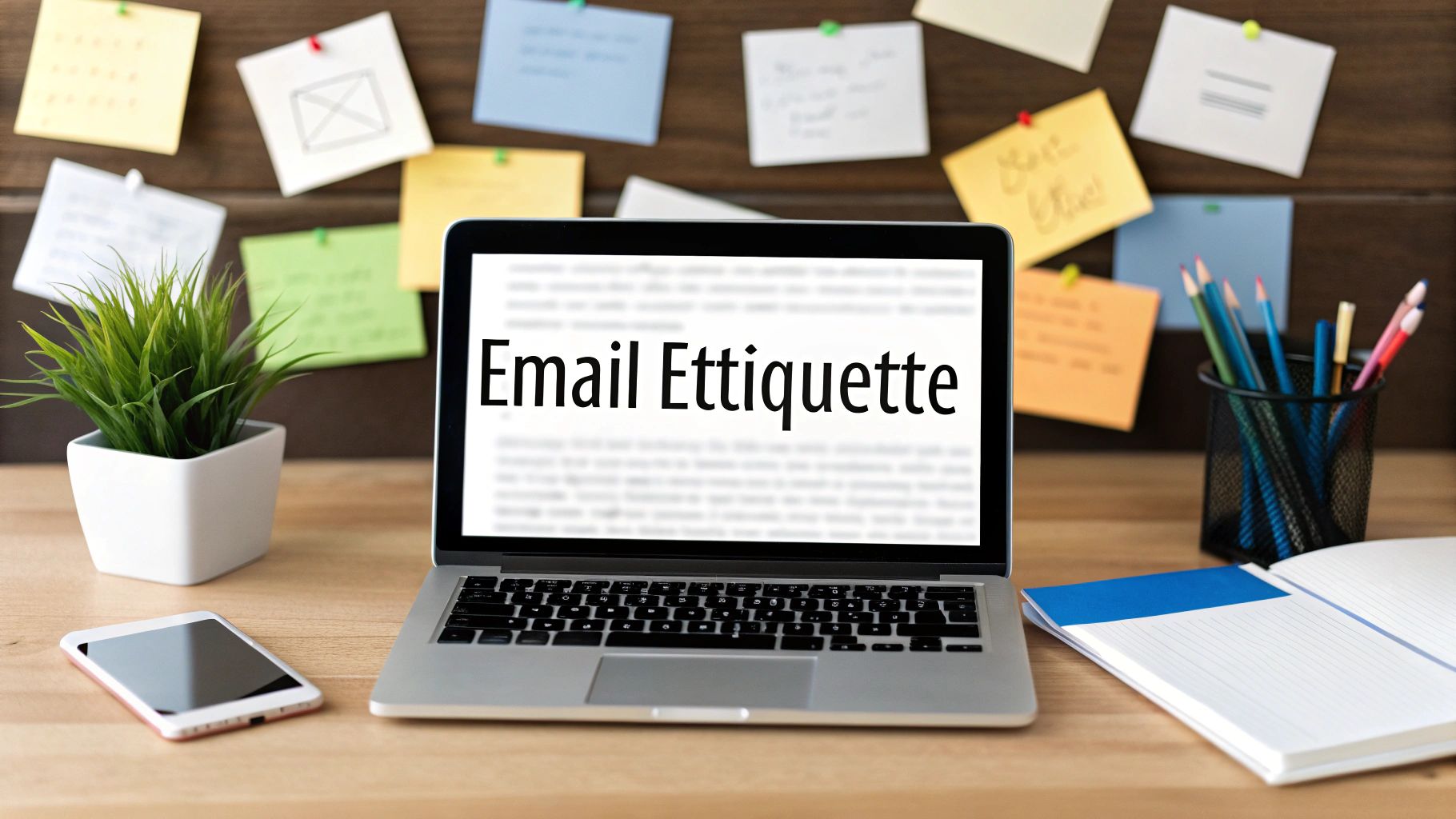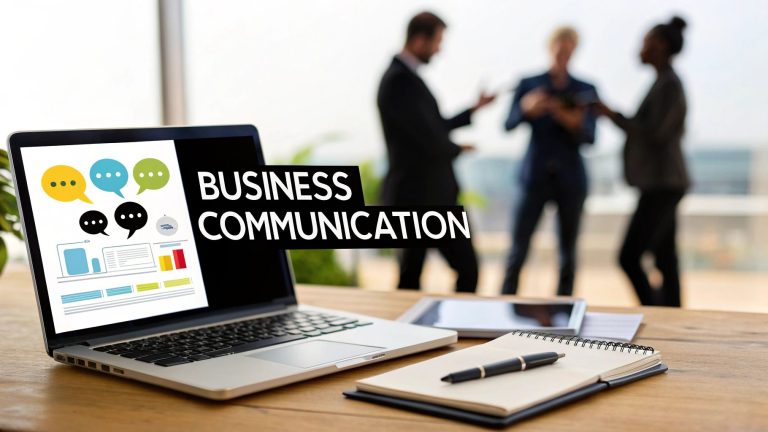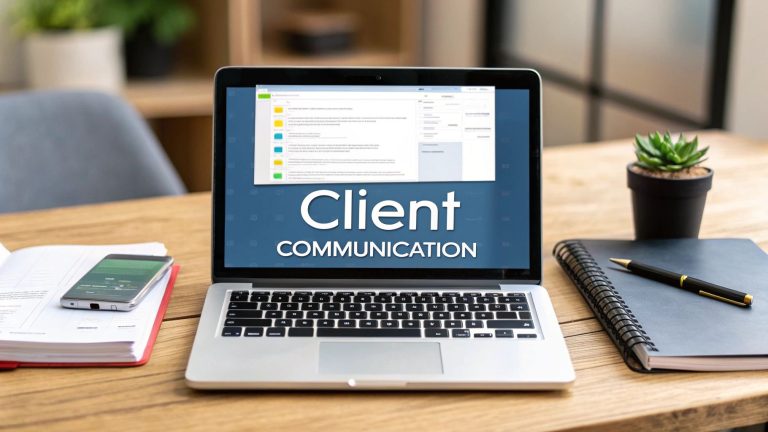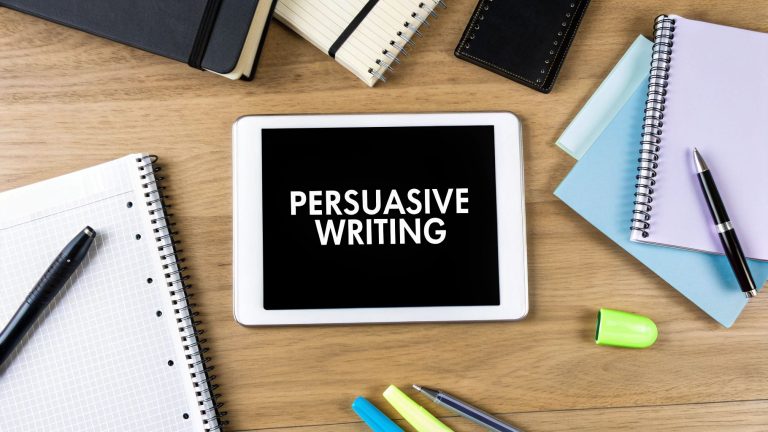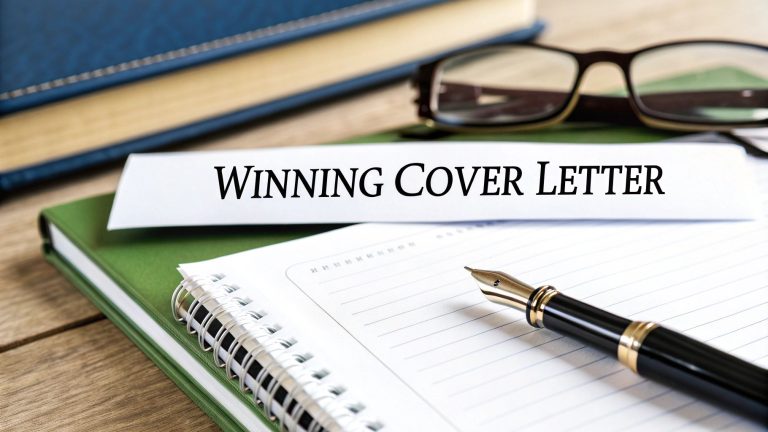In professional communication, your emails are a direct reflection of your competence and attention to detail. A poorly constructed message can lead to confusion, missed opportunities, or a damaged reputation. Conversely, a clear, concise, and professional email builds trust, drives action, and strengthens relationships. Good email etiquette isn't just about being polite; it's a strategic tool for achieving specific outcomes.
This guide moves beyond theory and dives straight into practical application. We will break down 10 essential email etiquette examples, covering common scenarios from meeting requests to delicate situations like declining an offer. For each example, you won't just get a template. We'll dissect the underlying strategy, pinpoint specific tactics, and provide actionable takeaways you can use immediately.
By the end of this article, you will have a clear framework for crafting emails that are not only professional but also highly effective. You'll learn how to handle any situation with confidence, ensuring your messages get the right response every time. This is your blueprint for turning simple correspondence into a powerful tool for career and business growth.
1. Professional Business Meeting Request Email
Requesting a meeting via email is a common professional task, yet it's easy to get wrong. A proper meeting request respects the recipient's time by being clear, concise, and actionable. The goal is to eliminate back-and-forth communication by providing all necessary details upfront, making it easy for the other person to say "yes" and add it to their calendar. This approach is a cornerstone of effective email etiquette examples because it demonstrates professionalism and consideration.
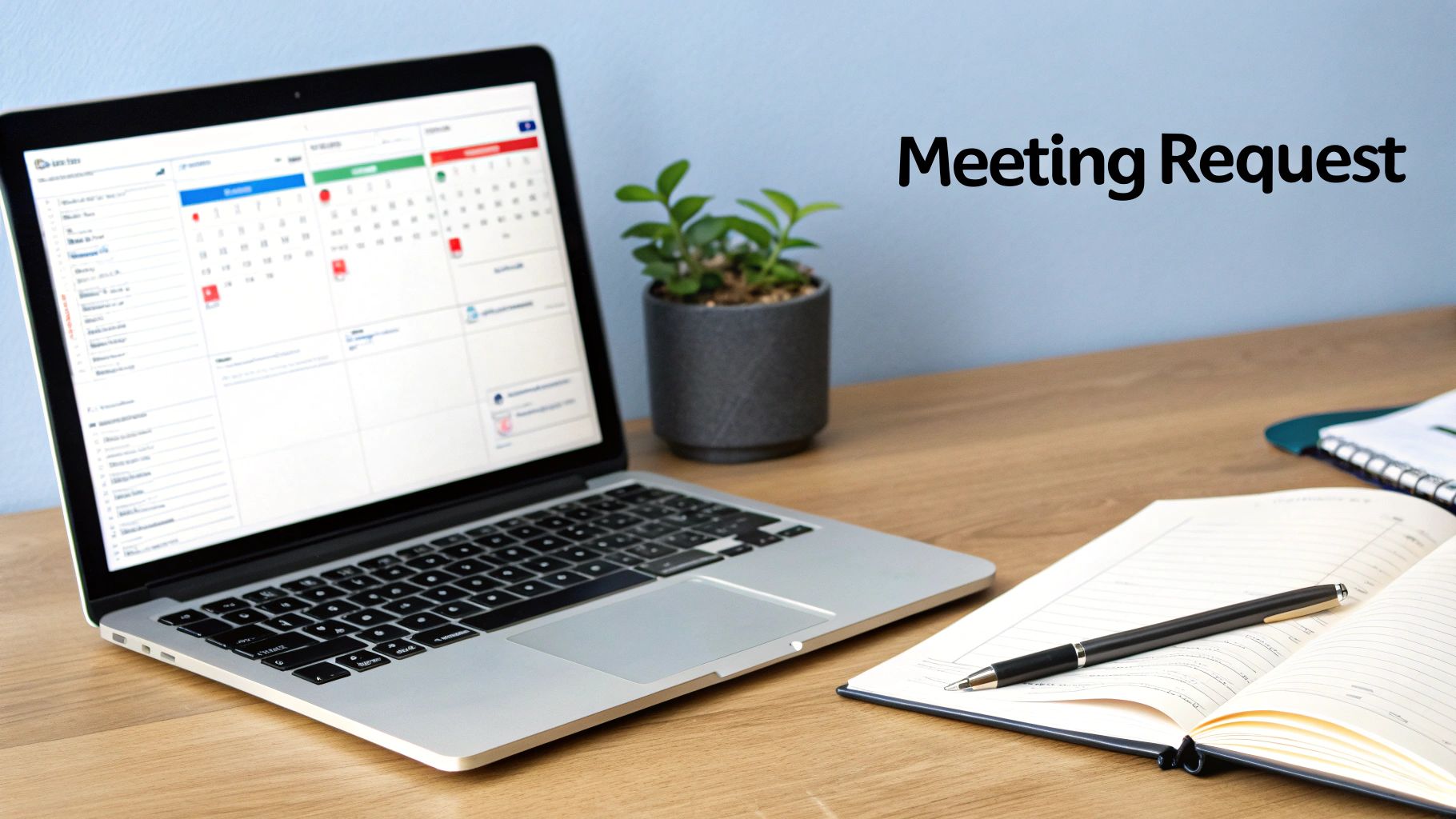
Strategic Breakdown
The best meeting requests are built on clarity and convenience. The subject line should be direct, like "Meeting Request: Q4 Project Discussion," so the purpose is immediately understood. The body of the email must state the meeting's objective, proposed duration, and format (e.g., a "30-minute Zoom call"). Offering specific time slots shows you've done the pre-work and makes scheduling simple.
Actionable Takeaways & Examples
Follow this structure for an effective and respectful meeting request that gets results. This model minimizes ambiguity and streamlines the scheduling process.
- Be Specific in the Subject: Use a clear and direct subject line.
- Good:
Meeting Request - Q4 Project Timeline - Bad:
Quick question
- Good:
- State the Purpose Clearly: Immediately tell them why you need to meet.
- Example: "I would like to schedule a 30-minute call to discuss the final deliverables for the Alpha project."
- Propose Concrete Options: Provide 2-3 specific dates and times. Include the time zone for remote participants.
- Example: "Are you available on Tuesday, October 26th at 10:00 AM PST or Wednesday, October 27th at 2:00 PM PST?"
- Include a Call to Action: End with a clear next step.
- Example: "Please let me know which of these times works for you, or suggest an alternative if none do."
For more guidance on crafting effective messages, you can find a wealth of professional email writing tips on Lettergenerator.co.
2. Apology and Correction Email
Mistakes happen in any professional setting, but how you address them can define your reputation. A well-crafted apology email is a critical tool for maintaining trust and resolving issues swiftly. It shows accountability, provides a clear path to resolution, and reassures stakeholders that preventative measures are in place. This type of message is one of the most important email etiquette examples because it turns a potential negative into an opportunity to demonstrate integrity and competence.
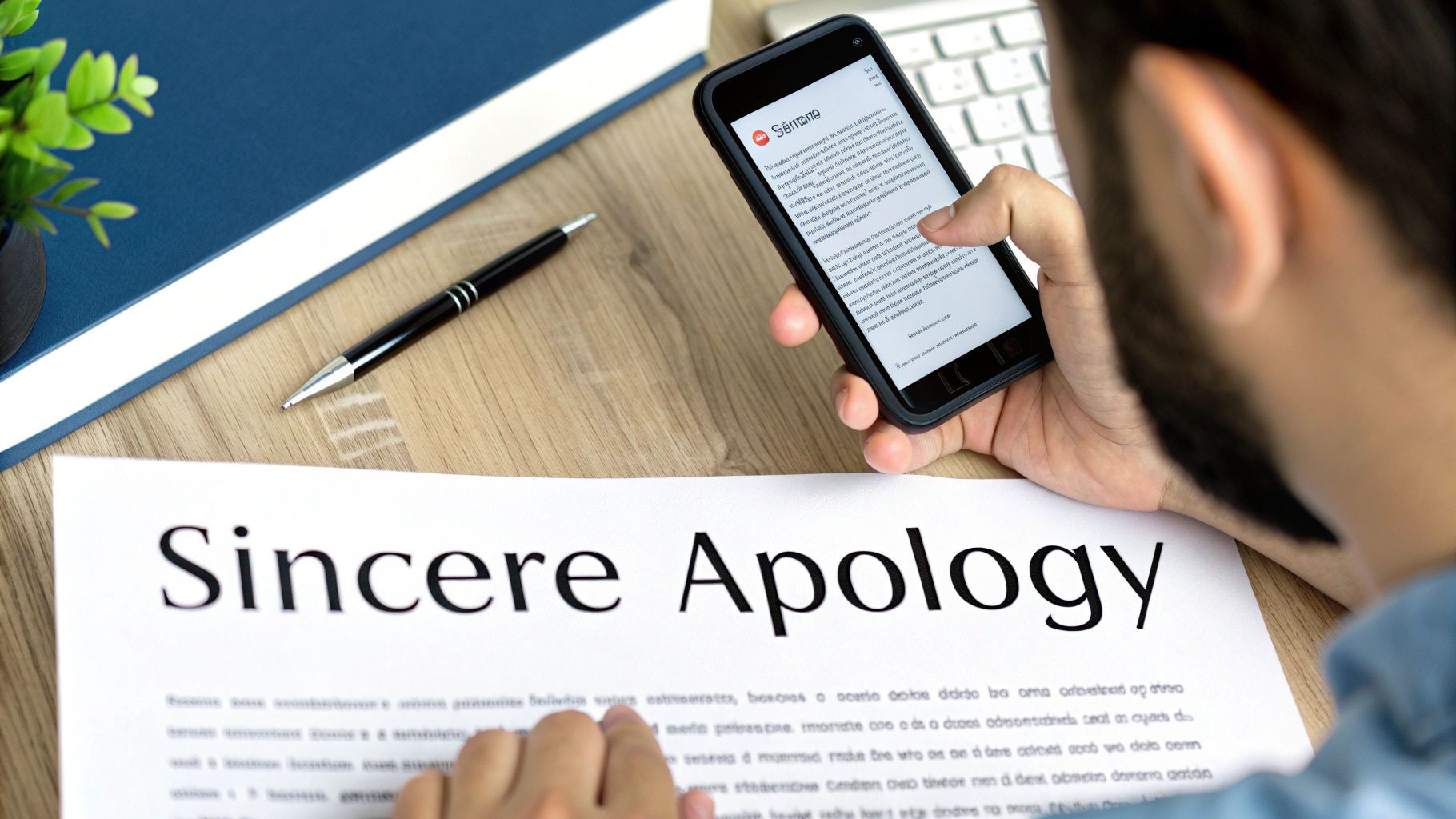
Strategic Breakdown
An effective apology email is built on three pillars: timeliness, transparency, and action. It should be sent as soon as the error is discovered to minimize its impact. The subject line must be direct, such as "Correction Regarding Yesterday's Report," to grab immediate attention. The email body needs to own the mistake without excuses, clearly explain the correction, and outline the steps you've taken to prevent a recurrence. This structured approach avoids blame and focuses on constructive solutions.
Actionable Takeaways & Examples
Use this framework to address errors professionally and maintain strong business relationships. This model helps you communicate accountability and a clear resolution plan.
- Be Direct and Prompt: Use a subject line that clearly states the purpose. Send the email as soon as possible.
- Good:
Correction: Updated Figures for Q3 Sales Report - Bad:
Oops
- Good:
- Take Clear Responsibility: Apologize directly and avoid defensive language or blaming others.
- Example: "I sincerely apologize for the error in the invoice sent this morning. The total was incorrect due to a data entry mistake on my part."
- Provide the Solution: Immediately offer the corrected information or action.
- Example: "I have attached the revised invoice with the correct figures. Please disregard the previous version."
- Outline Preventative Steps: Briefly explain what you will do to avoid similar issues in the future.
- Example: "To prevent this from happening again, I have implemented a new double-check process for all outgoing invoices."
3. Thank You and Recognition Email
Acknowledging a colleague's hard work is a powerful yet often overlooked professional courtesy. A well-crafted thank you email goes beyond a simple "good job" by specifically recognizing an individual's contribution and its positive impact. This form of communication boosts morale, fosters a collaborative environment, and is a key component of strong email etiquette examples. It shows that you value your team members' efforts and are paying attention to their achievements.

Strategic Breakdown
An effective recognition email is genuine, specific, and timely. Its purpose is to make the recipient feel seen and appreciated. The subject line should be warm and direct, such as "Thank you for your incredible work." The email body must clearly state what the person did and explain the tangible, positive result of their action. Copying their manager is a great way to give their accomplishment visibility. While we focus on written gratitude, understanding the principles of expressing thanks verbally can also be beneficial, as detailed in this guide to delivering a heartfelt thank you speech.
Actionable Takeaways & Examples
Use this framework to write a meaningful thank you email that builds strong professional relationships and motivates your colleagues.
- Be Specific About the Action: Clearly state what you are thankful for.
- Good:
Thank you for your exceptional work on the client presentation. - Bad:
Thanks for your help.
- Good:
- Explain the Positive Impact: Connect their action to a successful outcome.
- Example: "Your attention to detail and creative approach directly contributed to winning the new account."
- Be Timely: Send the recognition email within a day or two of the achievement.
- Example: "I wanted to send a quick note to say thank you for stepping in to lead yesterday's client call."
- Consider Visibility: Copying a manager or team lead can amplify the praise.
- Example: "CC'ing Sarah so she is aware of your outstanding contribution."
For more detailed templates, check out these excellent thank you note examples.
4. Declining an Invitation or Offer Email
Knowing how to tactfully decline an invitation or offer is a crucial skill in professional communication. A well-crafted rejection email shows respect for the sender's time and effort while preserving the relationship. The goal is to be appreciative, direct, and gracious, ensuring you leave the door open for future opportunities. This is a vital part of good email etiquette examples as it demonstrates politeness and professionalism even when delivering a negative response.
Strategic Breakdown
The strategy behind a polite refusal is to balance gratitude with clarity. Start by genuinely thanking the person for the opportunity. A prompt response is essential, as it allows the other party to make alternative plans. State your inability to accept clearly but without excessive detail; a brief, honest reason is sufficient. Concluding on a positive note, such as expressing interest in future collaborations, maintains goodwill and keeps professional connections strong.
Actionable Takeaways & Examples
Follow this framework to decline offers respectfully, ensuring you maintain a positive professional image. This model helps you say "no" without burning bridges.
- Respond Promptly and Appreciatively: Acknowledge the offer as soon as possible and express gratitude.
- Good:
Thank you so much for the invitation to the annual marketing conference. - Bad:
Can't make it.
- Good:
- State Your Decline Clearly and Briefly: Be direct but polite. You don't need to over-explain.
- Example: "Unfortunately, I will be unable to attend as I have a prior commitment on that date."
- Keep the Door Open: Express your desire to connect in the future.
- Example: "I was disappointed to miss it, as the topic is very relevant to my work. I hope to be able to join next year."
- End on a Positive Note: Close the email with a warm and professional sign-off.
- Example: "Thank you again for thinking of me. I wish you a successful event."
Declining a job offer requires a similar, yet more specific, approach. You can learn how to decline a job offer gracefully on Lettergenerator.co.
5. Follow-Up Email After Meeting or Interview
Sending a follow-up email after a meeting or interview is a critical yet often overlooked step in professional communication. It reinforces your appreciation for the other person's time, recaps key discussion points, and clarifies the next steps. This simple action is one of the most effective email etiquette examples because it demonstrates proactivity, attention to detail, and a genuine interest in maintaining momentum.
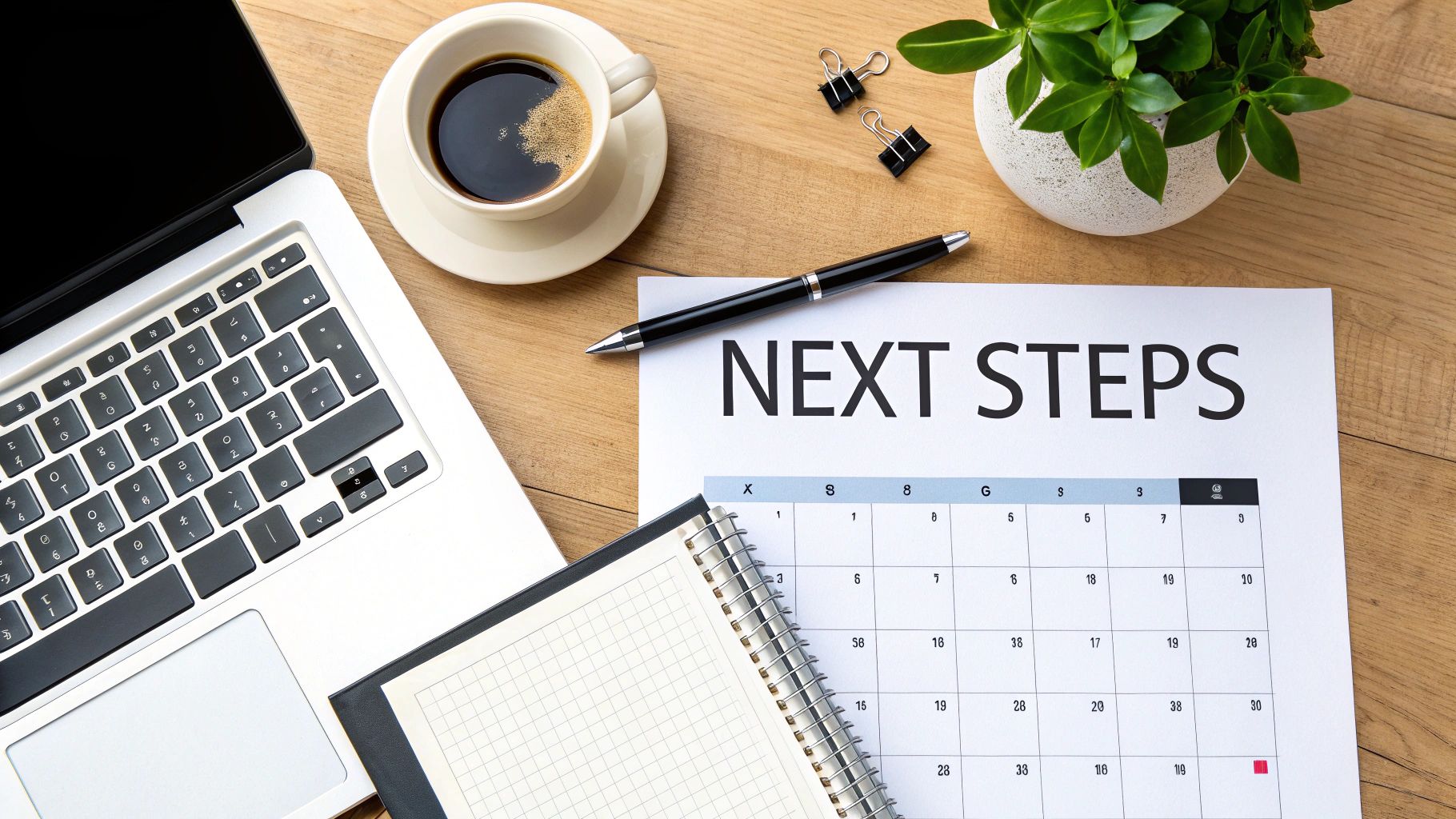
Strategic Breakdown
An effective follow-up is timely and specific. Sending it within 24 hours keeps the conversation fresh in the recipient's mind. The subject line should be easy to reference, such as "Following Up on Our Project Scope Discussion." The email's body should thank the recipient, briefly mention a specific point from the conversation to show you were engaged, and outline any agreed-upon action items. This transforms a simple "thank you" into a productive tool.
Actionable Takeaways & Examples
Use this structure to craft a concise and impactful follow-up that strengthens professional relationships and keeps projects moving forward.
- Be Timely and Relevant: Send the email within 24 hours with a clear subject line.
- Good:
Following up: Interview for Marketing Manager Role - Bad:
Re: our chat
- Good:
- Reference Specific Points: Mention something concrete you discussed to personalize the message.
- Example: "I particularly enjoyed our conversation about the new content strategy and your ideas for its implementation."
- Clarify Next Steps: State any deliverables, deadlines, or future meetings clearly.
- Example: "As discussed, I will send over the initial proposal by EOD Friday. We can then schedule a brief call next week to review."
- Keep it Concise: Aim for a brief email of 3 to 5 sentences that is easy to read and act upon.
- Example: "Thank you again for your time. I look forward to connecting next week."
For more detailed templates, explore these examples of how to write an email after an interview on Lettergenerator.co.
6. Professional Complaint or Concern Email
Addressing a complaint or concern via email requires a delicate balance of directness and professionalism. The goal is to raise an issue constructively, focusing on facts and potential solutions rather than placing blame. A well-crafted complaint email is one of the most important email etiquette examples because it turns a potentially negative interaction into a productive conversation, preserving professional relationships while seeking resolution. This approach demonstrates maturity and a commitment to improving the situation.
Strategic Breakdown
A successful complaint email avoids emotional or accusatory language. Instead, it presents the issue objectively with specific, fact-based evidence. The subject line should be clear yet neutral, like "Question Regarding Project Workflow." The body of the email must calmly state the problem, provide context with specific examples or dates, and explain the impact of the issue. The key is to shift the focus from a complaint to a collaborative problem-solving effort.
Actionable Takeaways & Examples
Use this framework to address workplace concerns respectfully and effectively. This model helps you advocate for a solution while maintaining a professional and composed tone.
- Use a Neutral Subject Line: Avoid overly negative or alarming subject lines.
- Good:
Following Up on Project Communication Protocols - Bad:
URGENT PROBLEM with the team
- Good:
- State the Concern Objectively: Describe the issue using factual, unemotional language.
- Example: "I am writing to discuss a concern regarding inconsistent team updates, which has led to confusion about deadlines."
- Provide Specific Evidence: Reference particular instances to support your concern.
- Example: "For instance, the deadline for the Q3 report was moved on Monday, but the update was not shared until Wednesday, causing rework."
- Focus on a Solution: End by suggesting a positive next step, like a discussion.
- Example: "Would you be open to a brief call this week to discuss creating a more centralized communication process?"
7. Introduction or Networking Email
Sending a cold networking email requires a delicate balance of confidence and respect. The goal is to make a genuine connection without seeming presumptuous or demanding. A well-crafted introduction email respects the recipient's time by being concise, personalized, and value-oriented. This approach is a critical component of strong email etiquette examples because it shows you've done your homework and value their expertise, making them more likely to respond positively.
Strategic Breakdown
An effective networking email immediately establishes relevance and credibility. Mentioning a mutual connection or a specific piece of their work shows your outreach is not random. The key is to shift the focus from what you want to what you admire about them or their work. Keep the message brief and make your request small and easy to fulfill, such as a "brief 15-minute chat," to lower the barrier to entry for a busy professional.
Actionable Takeaways & Examples
Follow this framework to craft a networking email that builds professional relationships instead of burning bridges. This model prioritizes respect and genuine interest.
- Lead with a Genuine Connection: Start by mentioning a mutual contact or a specific reason for your interest.
- Good:
Hi [Name], [Mutual Contact] suggested I reach out after our conversation about sustainable technology. - Bad:
Dear Sir/Madam, I want a job.
- Good:
- Keep it Short and to the Point: Your initial email should be no more than 3-4 concise sentences.
- Example: "I was incredibly impressed by your recent article on AI ethics in the tech industry. Your perspective on data privacy is particularly relevant to my work at [Your Company/Project]."
- Personalize Your Message: Show you've researched the recipient. Avoid generic, copy-paste templates at all costs.
- Example: "I noticed your work on the [Project Name] and would love to learn more about how you navigated the initial funding stages."
- Use a Soft Call-to-Action: Make your request low-commitment and easy to agree to.
- Example: "Would you be open to a brief 15-minute call next week to share your insights? If not, I completely understand."
8. Deadline Extension or Delay Notification Email
Communicating a project delay or requesting a deadline extension can be uncomfortable, but handling it professionally is crucial. A well-crafted notification email respects your stakeholders' time and planning by giving them advance notice and demonstrating your accountability. This approach is a key part of email etiquette examples because it turns a potentially negative situation into a showcase of responsibility and proactive problem-solving, preserving trust and professional relationships.
Strategic Breakdown
The most effective delay notifications are built on transparency and forward-thinking. The subject line must be direct, such as "Update on Project X Deadline," to avoid any surprises. The body of the email should clearly state the delay, provide a concrete new deadline, and briefly explain the reason without making excuses. Crucially, it should also outline the steps you're taking to mitigate the impact, showing that you are in control of the situation.
Actionable Takeaways & Examples
Use this framework to communicate delays professionally while maintaining stakeholder confidence. This model minimizes disruption and reinforces your reliability.
- Notify Early and Directly: Inform stakeholders as soon as you anticipate a delay.
- Good:
Update: New Delivery Date for Q3 Report - Bad:
Uh oh
- Good:
- State the New Timeline Clearly: Provide a specific new date, not a vague estimate.
- Example: "I am writing to inform you that the project deliverable, originally due this Friday, will be delayed. The new submission date will be Tuesday, November 9th."
- Provide a Brief, Honest Reason: Explain why the delay occurred without over-explaining or blaming others.
- Example: "This is due to an unforeseen issue with the data integration, which we are actively resolving."
- Show Proactive Management: Explain what you're doing to manage the delay's impact.
- Example: "To minimize any disruption, I have already completed the preliminary analysis, which I can share with your team by tomorrow."
9. Feedback Request Email
Requesting feedback via email shows a commitment to professional growth, but it must be done with care. A well-crafted feedback request respects the other person's time and expertise by being specific, humble, and non-demanding. The objective is to make it easy for your colleague or supervisor to provide targeted, constructive input without feeling burdened. This type of message is one of the most valuable email etiquette examples because it fosters a culture of continuous improvement and strengthens professional relationships.
Strategic Breakdown
An effective feedback request is built on clarity and respect. The subject line should clearly state the purpose, such as "Feedback on Q3 Presentation Draft." In the email body, you must specify exactly what you need feedback on and why their perspective is valuable. This prevents vague, unhelpful responses and shows you have already reflected on your work. By framing the request with humility and providing a soft deadline, you make it a low-pressure, high-value interaction for the recipient.
Actionable Takeaways & Examples
Use this structure to request feedback in a way that is professional, direct, and likely to receive a thoughtful response. This model removes ambiguity and encourages genuine, helpful criticism.
- Be Direct in Your Subject Line: Clearly state the topic and your need for feedback.
- Good:
Feedback Request: Project Alpha Proposal - Bad:
Got a sec?
- Good:
- Specify What You Need Feedback On: Don't ask for general thoughts. Pinpoint specific areas for review.
- Example: "I would appreciate your feedback on my presentation skills from this morning's meeting, particularly regarding clarity and audience engagement."
- Provide Context and a Timeline: Explain the situation and suggest a reasonable deadline for their response.
- Example: "If you have a moment this week, could you provide your thoughts by Friday? I'm hoping to apply your suggestions before the final client review."
- Express Gratitude and Openness: Thank them in advance and show you are open to all comments.
- Example: "I'm committed to improving and truly value your perspective. Thank you for your time and insights."
10. Resignation or Notice of Departure Email
Submitting your resignation is a critical career moment, and how you do it matters. A professional resignation email maintains goodwill and leaves a lasting positive impression. The objective is to formally state your intention to leave, specify your final day, and offer support for a smooth transition. This is a vital entry in our list of email etiquette examples because it shows how to end a professional relationship on respectful and constructive terms.
Strategic Breakdown
The most effective resignation emails are direct, professional, and positive. The subject line must be unambiguous, such as "Resignation – [Your Name]," leaving no room for misinterpretation. The body should clearly state your resignation and effective last date, which is typically two weeks from the notice date. Crucially, it should express gratitude for the opportunity and avoid any criticism of the company or its employees, preserving professional relationships for the future.
Actionable Takeaways & Examples
Use this template to craft a resignation email that is graceful and professional. This approach ensures you handle your departure with dignity and maintain your network.
- Use a Clear, Formal Subject: Make the email's purpose immediately clear.
- Good:
Resignation - Jane Doe - Bad:
Moving on
- Good:
- State Your Intentions Directly: Open the email by clearly stating you are resigning and providing your last day of employment.
- Example: "Please accept this email as formal notification that I am resigning from my position as Marketing Manager, effective two weeks from today, [Your Last Day]."
- Express Gratitude: Briefly thank the company for the experience and opportunities.
- Example: "I am very grateful for the opportunities I've had during my time at [Company Name] and the professional growth it has afforded me."
- Offer to Assist with the Transition: Show your commitment to a seamless handover.
- Example: "I am dedicated to ensuring a smooth transition and am happy to assist in training my replacement and documenting my responsibilities."
For more detailed guidance on handling this important step, you can learn more about how to write a resignation letter on Lettergenerator.co.
Comparison of 10 Email Etiquette Examples
| Template | Implementation Complexity | Resource Requirements | Expected Outcomes | Ideal Use Cases | Key Advantages |
|---|---|---|---|---|---|
| Professional Business Meeting Request Email | Low — simple structure | Calendar options, concise agenda, contact info | Scheduled meeting with clear purpose | Setting meetings with colleagues, clients, managers | Professional tone; reduces scheduling back‑and‑forth |
| Apology and Correction Email | Low–Medium — careful wording required | Accurate facts, corrected documents, corrective plan | Restored trust and corrected record | Addressing errors or miscommunications | Shows accountability; prevents escalation |
| Thank You and Recognition Email | Low — straightforward | Specific examples, timing, recipient name | Improved morale and stronger relationships | Acknowledging contributions or wins | High impact with minimal effort |
| Declining an Invitation or Offer Email | Low — tactful phrasing | Brief reason, polite closing, optional alternatives | Maintained goodwill despite refusal | Declining events, meetings, or offers | Preserves relationships; clear and respectful |
| Follow-Up Email After Meeting or Interview | Low — timely and concise | Meeting notes, action items, deadlines | Alignment on next steps and documented outcomes | Post-meeting or post-interview follow-up | Reinforces momentum; clarifies responsibilities |
| Professional Complaint or Concern Email | Medium — neutral and factual tone needed | Specific examples, impact statements, suggested solutions | Increased likelihood of resolution and documentation | Raising workplace issues or policy concerns | Solution-focused; preserves professionalism |
| Introduction or Networking Email | Low–Medium — requires personalization | Research, mutual contact or value proposition | New connection or opportunity for collaboration | Cold outreach, networking, introductions | Opens doors; demonstrates initiative |
| Deadline Extension or Delay Notification Email | Low — direct and timely | Reason for delay, new timeline, mitigation steps | Adjusted expectations and retained trust | Communicating project delays or extension requests | Proactive transparency; minimizes surprises |
| Feedback Request Email | Low — focused questions help | Specific topics, timeline for response | Actionable feedback and development insights | Seeking performance or project feedback | Shows growth mindset; yields improvements |
| Resignation or Notice of Departure Email | Low–Medium — formal and complete | Last day, notice period, transition offer | Formal exit and planned transition | Submitting resignation professionally | Preserves reputation; facilitates handover |
Turn Your Knowledge Into Action with Smarter Tools
Throughout this guide, we've moved beyond simple templates to deconstruct the anatomy of effective communication. We’ve analyzed a wide range of email etiquette examples, from requesting a meeting and issuing an apology to navigating sensitive topics like resignations and formal complaints. The common thread connecting every successful email is not a magic formula but a strategic blend of clarity, respect, and proactivity.
Mastering these skills transforms your inbox from a daily chore into a powerful engine for building relationships, reinforcing your professionalism, and driving career growth. Every email you send is a reflection of your personal brand. A well-crafted message demonstrates that you are considerate, organized, and capable of handling complex situations with grace.
Key Principles for Lasting Impact
As you apply these lessons, keep these core principles at the forefront of your communication strategy:
- Clarity Above All: Never leave your reader guessing your purpose. A clear subject line, a direct opening, and a specific call to action are non-negotiable elements.
- Empathy is Your Superpower: Always consider the recipient's perspective. How will your tone be perceived? What information do they need to take the next step? This empathetic approach is the foundation of strong email etiquette.
- Proactivity Prevents Problems: Whether you're notifying someone of a delay or asking for feedback, being proactive shows foresight and respect for others' time. It builds trust and minimizes potential friction.
- Structure Creates Success: The examples in this article prove that a logical flow, including a proper greeting, a concise body, and a professional sign-off, makes your message easier to digest and act upon.
From Understanding to Mastery
The journey from understanding email etiquette to mastering it is one of continuous practice and refinement. The goal isn't just to avoid mistakes but to actively leverage your communication to achieve specific outcomes. Each interaction is an opportunity to strengthen a professional connection, resolve an issue efficiently, or move a project forward. By consistently applying the strategic insights from these email etiquette examples, you will build a reputation as a clear, reliable, and effective communicator.
To gain deeper insights and practical advice on leveraging technology for better email etiquette and overall communication strategies, consider checking out Parakeet-AI's blog for further insights. Combining proven principles with modern tools can significantly enhance your efficiency and impact. The principles we’ve covered provide the "why," and smart technology can now provide the "how," helping you implement these best practices effortlessly.
Ready to draft flawless emails in seconds? The AI Letter Generator uses the same principles of clarity, tone, and structure discussed here to create polished, situation-specific emails instantly. Stop staring at a blank screen and let technology handle the first draft, so you can focus on building relationships. Try the AI Letter Generator today!
